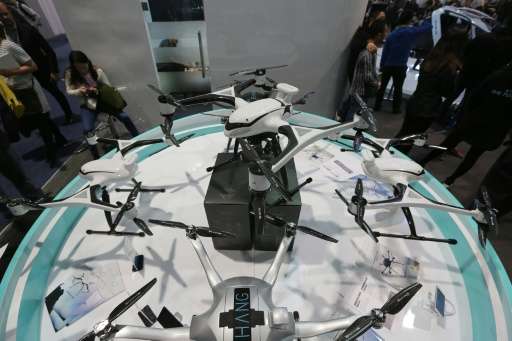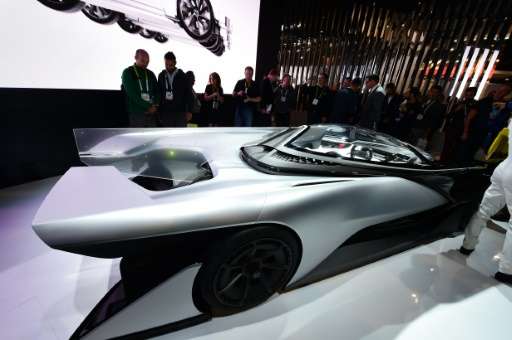Transport of the future takes many shapes at tech show

In the future world of mobility, you might be traveling in a car, on a bike or a personal air transporter—with a range of new possibilities raised by connected technology.
Many of the exhibitors at the Consumer Electronics Show in Las Vegas offered their vision of mobility made easier by connectivity.
Chinese drone manufacturer EHang sees a future by air. Its 1.5-meter (five foot) long quadcopter on display at the show can carry one person and squeeze into a car parking space.
"It's not a drone. It's an autonomous aerial vehicle," said EHang vice president Claire Chen.
While the company faces a number of regulatory obstacles—it doesn't fit into drone regulations and it's not a road vehicle—Chen said that "we are ready to sell to anybody."
The EHang 184 prototype being tested in China is designed so the user can push a button for a destination and arrive by automatic pilot. It can now travel above traffic for 23 minutes. The price tag is in the range of $200,000 to $300,000.
Other visions are more down to earth. Ford Motor Co. was showing its folding electric bicycle, which fits in the trunk of a car that maintains data connectivity to a smartphone.
Ford's eBike enables "multimodal" transportation where a traveler can go part of a journey by car, and the rest by bicycle—a two-wheeler which is guided by GPS and a uses a vibrating warning system for an approaching vehicle.

The underlying technology for smart transport was also on display at CES. Japanese equipment maker Denso unveiled its new system of vehicle to vehicle (V2V) communication designed for accident avoidance and reducing congestion.
Denso's Patrick Powell, who heads the group's "smart city" activities, says these systems can play an important role by connecting with traffic signals in real time, cutting down on traffic jams and allowing for a smoother vehicle flow.
Transport as a service
Industry executives at CES recognize that people's relationships with their vehicles may be changing: Some people may not want to own and maintain a car, and new models are being examined.
The concept of car sharing was being talked about at the show, by big automakers as well as the startup Faraday Future, which unveiled a concept electric car it plans to produce.
"We're completely rethinking how we approach the business, with one foot today and one foot tomorrow," Ford chief executive Mark Fields said at CES.
"We are very proud to be an auto maker... but at the same time, beginning this year, you're going to see us change pretty dramatically, becoming an automotive and mobility company. You'll see us focus even more attention on the transportation services sectors."
Ford is already looking into on-demand car-sharing models, aiming at millennials who may not want to own a vehicle.
General Motors signaled its own interest in these alternative models by announced a $500 million investment in ride-sharing service Lyft. The two companies also said they will study ways to create a network of self-driving vehicles available on-demand for customers.
Autonomy changes the game
As cars move closer to full autonomy, this changes the game for consumers. Many may not see the need to own a car if they can signal one instantly with a smartphone.
And the marketing of the driving experience may also change, says Edmunds.com analyst Ron Montoya.
"Ultimately, when the car drives itself, it doesn't matter what you drive," Montoya said.
Many automakers have been talking about self-driving cars, and ramping up some features like automatic parking and lane guidance as an interim step. South Korea's Kia said it expects to put a fully autonomous car on the road by 2030.
It may take that much time to sort out issues about regulation, liability and other obstacles to self-driving cars.
© 2016 AFP



















